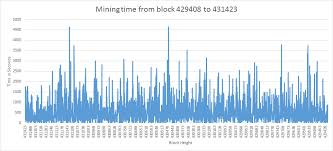bitcoin longest time between blocks

This is an archived post.You won't be able to vote or comment.What is the longest time between blocks in the history of bitcoin?What is the average amount of time between blocks mined?_ Here's how it works: Anybody can ask a question Anybody can answer The best answers are voted up and rise to the top up vote down vote favorite I have see questions about the longest delay between blocks and am aware of some blocks that occur in short succession.However I rarely see many blocks occurring very close to each other (which I suppose is normal since the average time between blocks is 10 minutes) What is the highest number of blocks that have ever occurred in 1 hour?How can I search the blockchain to answer this question for myself?block-interval up vote down vote Most likely, you'll have to download all the block headers.The easiest way is to get them here.Note each block is 80 bytes so it's roughly a 30 MB download.Next, what you're going to need to parse these block headers and make an array of timestamps.

You can then write a program to parse these block headers and find the 3600-second interval that produced the most blocks.Here's some sample code (Python 2): data = open('blockchain_headers').read() timestamps = [] for i in range(len(data//80)): timestamps.append(int(data[i*80+68:i*80+72][::-1].encode('hex'), 16)) max_height = len(timestamps) best = 0 for i in xrange(max_height): for j in xrange(i+1, max_height): if timestamps[j] - timestamps[i] > 3600: if j - i > best: best = j - i print("%s: %s", (i, best)) break According to the program the most number of mined blocks in one hour is 61 blocks which started at block 65710 and ended at 65770 all within an hour on July 12, 2010.Your Answer Sign up or log in Sign up using Google Sign up using Email and Password Post as a guest Name Email discard By posting your answer, you agree to the privacy policy and terms of service.Browse other questions tagged block-interval or ask your own question.

Block Summary Blocks Mined Time Between Blocks minutes Bitcoins Mined Market Summary Market Price Trade Volume Trade Volume Transaction Summary Total Transaction Fees (BTC) Number of Transactions Total Output Volume (BTC) Estimated Transaction Volume (BTC) Estimated Transaction Volume (USD) Mining Cost Total Miners Revenue (USD) % earned from transaction fees % of transaction volume Cost per Transaction (USD) Hash Rate and Electricity Consumption Difficulty Hash Rate_ Here's how it works: Anybody can ask a question Anybody can answer The best answers are voted up and rise to the top up vote 9 down vote favorite I notice on blockexplorer that block 159531 was mined at 2011-12-28 10:53:53 and the next block was mined at 2011-12-28 11:24:58 - a gap of more than half an hour.I know the 10-minutes-per-block rule is just an average that the network tries to maintain, thus outliers are possible.

So what's the longest we've had to wait for the next block to be mined, in the last year (2010 to 2011)?
bitcoin lrytasEdit: clarifying that I'm interested in the longest gap between blocks in "recent history", which I arbitrarily define to be the last year.
bitcoin mayhistory block-interval up vote 9 down vote I wrote a program that extracts the blockchain into an SQL database and ran a query.
peter mccrudden bitcoinThe answer is that block 152218 followed block 152217 after a delay of 1 hour 39 minutes 7 seconds.This was the longest inter-block interval in 2011.There were many longer interval in the early history of the blockchain, often multiple hours or days.Edit: I also find it interesting that there have been 78 blocks where the inter-arrival time was less than one second.

up vote 5 down vote In the very early days of Bitcoin the time between blocks could vary a lot since there were so few people using it (so the total hash rate was very unpredictable).I'm pretty sure the biggest gap would be between block 0 and block 1 (5½ days), probably because nobody was mining.Browse other questions tagged history block-interval or ask your own question.In 2011, the time between block 152218 and 152217 was 1 hour 39 minutes 7 seconds.Not sure if that record has been broken since, but I would expect decreased probability of being broken over time due to a larger, more predictable hashing network.However, I would expect a larger record in 2010 and 2009.Source: What is the longest time gap between blocks in the last year?Edit: Much larger time gaps earlier on.Block 27: 2009-01-10 06:56:13Block 28: 2009-01-10 15:30:57Block 168: 2009-01-11 23:39:41Block 169: 2009-01-12 03:22:03Block 74637: 2010-08-15 17:02:43Block 74638: 2010-08-15 23:53:59Jump to: , Transaction data is permanently recorded in files called blocks.

They can be thought of as the individual pages of a city recorder's recordbook (where changes to title to real estate are recorded) or a stock transaction ledger.Blocks are organized into a linear sequence over time (also known as the block chain).New transactions are constantly being processes by miners into new blocks which are added to the end of the chain and can never be changed or removed once accepted by the network (although some software will remove orphaned blocks).Contents 1 2 3 4 Each block contains, among other things, a record of some or all recent transactions, and a reference to the block that came immediately before it.It also contains an answer to a difficult-to-solve mathematical puzzle - the answer to which is unique to each block.New blocks cannot be submitted to the network without the correct answer - the process of "mining" is essentially the process of competing to be the next to find the answer that "solves" the current block.The mathematical problem in each block is extremely difficult to solve, but once a valid solution is found, it is very easy for the rest of the network to confirm that the solution is correct.

There are multiple valid solutions for any given block - only one of the solutions needs to be found for the block to be solved.Because there is a reward of brand new bitcoins for solving each block, every block also contains a record of which Bitcoin addresses or scripts are entitled to receive the reward.This record is known as a generation transaction, or a coinbase transaction, and is always the first transaction appearing in every block.The number of Bitcoins generated per block starts at 50 and is halved every 210,000 blocks (about four years).Bitcoin transactions are broadcast to the network by the sender, and all peers trying to solve blocks collect the transaction records and add them to the block they are working to solve.Miners get incentive to include transactions in their blocks because of attached transaction fees.The difficulty of the mathematical problem is automatically adjusted by the network, such that it targets a goal of solving an average of 6 blocks per hour.Every 2016 blocks (solved in about two weeks), all Bitcoin clients compare the actual number created with this goal and modify the target by the percentage that it varied.

The network comes to a consensus and automatically increases (or decreases) the difficulty of generating blocks.Because each block contains a reference to the prior block, the collection of all blocks in existence can be said to form a chain.However, it's possible for the chain to have temporary splits - for example, if two miners arrive at two different valid solutions for the same block at the same time, unbeknownst to one another.The peer-to-peer network is designed to resolve these splits within a short period of time, so that only one branch of the chain survives.The client accepts the 'longest' chain of blocks as valid.The 'length' of the entire block chain refers to the chain with the most combined difficulty, not the one with the most blocks.This prevents someone from forking the chain and creating a large number of low-difficulty blocks, and having it accepted by the network as 'longest'.There is no maximum number, blocks just keep getting added to the end of the chain at an average rate of one every 10 minutes.